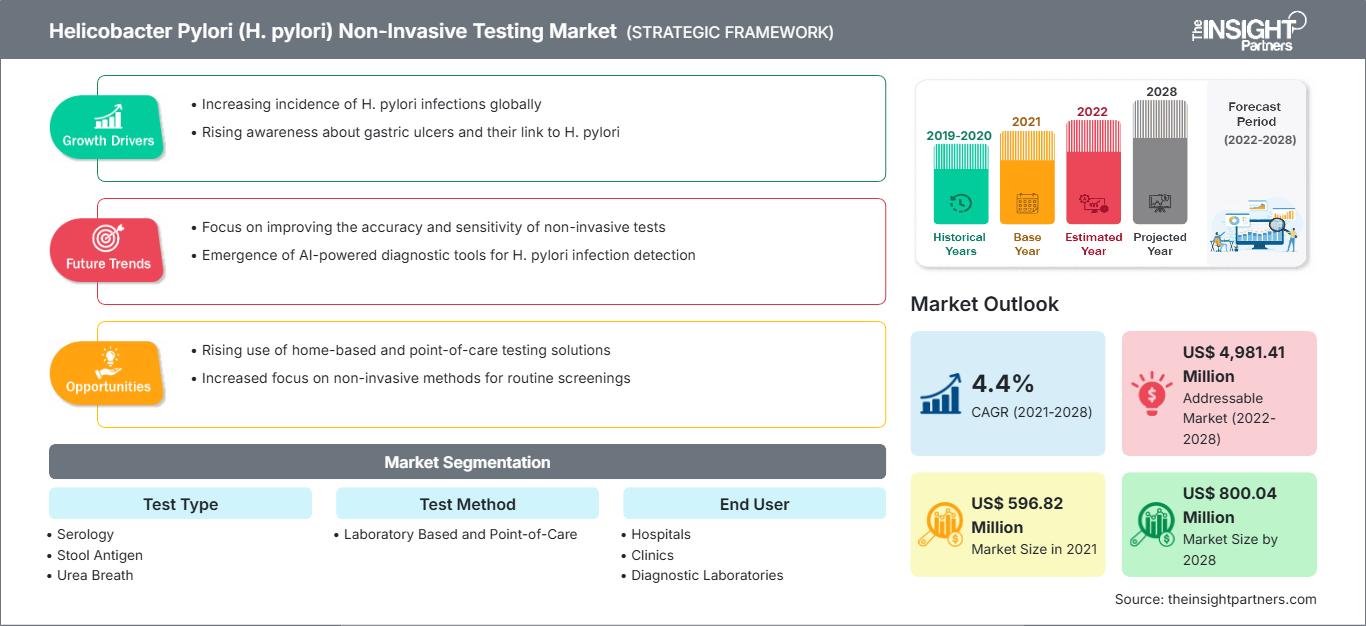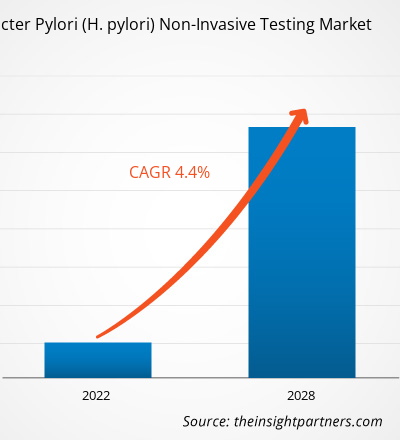Der Markt für nicht-invasive Tests auf Helicobacter Pylori (H. pylori) wird voraussichtlich von 596,82 Millionen US-Dollar im Jahr 2021 auf 800,04 Millionen US-Dollar im Jahr 2028 wachsen; von 2022 bis 2028 wird mit einer durchschnittlichen jährlichen Wachstumsrate von 4,4 % gerechnet.
Die steigende Prävalenz von H. pylori-Infektionen und der technologische Fortschritt treiben das allgemeine Marktwachstum voran. Darüber hinaus bieten die von den großen Akteuren umgesetzten Strategien lukrative Möglichkeiten auf dem Weltmarkt.
Helicobacter Pylori (HP) ist ein Hauptfaktor, der für Magengeschwüre und Gastritis verantwortlich ist. Laut dem Bericht der Public Library of Science (PLOS) ist ungefähr ein Drittel aller Erwachsenen in Nordeuropa und Nordamerika mit HP infiziert, wobei die Prävalenz in Afrika, Süd- und Südamerika sehr hoch ist. 50 % entfallen auf Mittelamerika, Asien sowie Süd- und Osteuropa. Auch unter Erwachsenen ist die HP-Infektionsrate hoch, mit einigen geografischen Abweichungen. So heißt es beispielsweise im Bericht des National Institute of Health (NIH), dass die H. pylori-Infektionsrate bei Jugendlichen 30–50 % beträgt und bei Erwachsenen in Entwicklungsländern 90 % erreicht.
Der Bericht von Clinical and Experimental Pediatrics (CEP) besagt, dass die Prävalenz der H. pylori-Infektion zurückgegangen ist. Obwohl die H. pylori-Infektionsrate in Südkorea und den Industrieländern zurückgegangen ist, sind laut demselben Bericht weltweit noch immer 33 % der asymptomatischen oder gesunden Kinder serologisch infiziert. So meldeten Industrieländer wie Japan, Deutschland, die Niederlande und die USA eine niedrige Seroprävalenz von 7,7 %, 11,8 %, 9,8 % bzw. 5,7 % im Jahr 2020. Hohe Infektionsraten von 27,2 %, 65,9 %, 25,8 % bzw. 40,4 % wurden im selben Jahr jedoch in Chile, Venezuela, Iran und Nigeria gemeldet. Daher beschleunigt die steigende Prävalenz von H. pylori-Infektionen die Nachfrage nach nicht-invasiven Tests und treibt letztlich das Wachstum des Marktes für nicht-invasive Tests auf Helicobacter Pylori (H. pylori) im Prognosezeitraum an.
Passen Sie diesen Bericht Ihren Anforderungen an
Sie erhalten kostenlos Anpassungen an jedem Bericht, einschließlich Teilen dieses Berichts oder einer Analyse auf Länderebene, eines Excel-Datenpakets sowie tolle Angebote und Rabatte für Start-ups und Universitäten.
Markt für nichtinvasive Tests auf Helicobacter Pylori (H. pylori): Strategische Einblicke

- Holen Sie sich die wichtigsten Markttrends aus diesem Bericht.Dieses KOSTENLOSE Beispiel umfasst Datenanalysen, die von Markttrends bis hin zu Schätzungen und Prognosen reichen.
Sie erhalten kostenlos Anpassungen an jedem Bericht, einschließlich Teilen dieses Berichts oder einer Analyse auf Länderebene, eines Excel-Datenpakets sowie tolle Angebote und Rabatte für Start-ups und Universitäten.
Markt für nichtinvasive Tests auf Helicobacter Pylori (H. pylori): Strategische Einblicke

- Holen Sie sich die wichtigsten Markttrends aus diesem Bericht.Dieses KOSTENLOSE Beispiel umfasst Datenanalysen, die von Markttrends bis hin zu Schätzungen und Prognosen reichen.
Helicobacter Pylori (H. pylori) ist eine bakterielle Infektion, die hauptsächlich bei Patienten mit Magen- oder Zwölffingerdarmgeschwüren festgestellt wird. Laut einem Bericht der Centers for Disease Control and Infection (CDC) beträgt die Prävalenz der H. pylori-Infektion weltweit etwa 50 % und in Entwicklungsländern etwa 80–90 %. In den USA wird die Prävalenz von H. pylori auf 35–40 % geschätzt. Die hohe Prävalenz der H. pylori-Infektion beeinflusst die Einführung nicht-invasiver Diagnoselösungen positiv. Technologische Fortschritte und Innovationen bei den nicht-invasiven H. pylori-Testlösungen bieten genaue Ergebnisse und eine höhere Patientenzufriedenheit bei Patienten mit bakteriellen Infektionen. Point-of-Care-Tests (POCT) beispielsweise liefern in kurzer Zeit genaue Ergebnisse zu einem erschwinglichen Preis. Da Menschen mit mehreren Gesundheitsproblemen in der Regel anfälliger für Infektionen sind und eine Früherkennung von H. pylori-Infektion, die bessere Zugänglichkeit von POCT und die leichte Verfügbarkeit zahlreicher invasiver und nicht-invasiver Geräte wirken sich positiv auf das Marktwachstum aus. So kündigte Biomerica, Inc. im Mai 2022 die Markteinführung eines neuen Produkts für die CE-Kennzeichnung für seinen Diagnosetest „hp+detect“ zum Nachweis von H. pylori-Bakterien an. Das neue Produkt „hp+detect“ dient zum Nachweis von H. pylori-Bakterien, die in den USA zu 35 % und in den fünf größten Ländern Europas zu 45 % vorkommen.
Die niedrige Diagnoserate stellt eine große Einschränkung für den Markt für nicht-invasive Tests auf Helicobacter pylori (H. pylori) dar. Ein niedriger sozioökonomischer Status oder ein niedriges Bildungsniveau werden mit einer erhöhten Prävalenz von H. pylori-Infektionen in Verbindung gebracht. In Australien beträgt die gepoolte H. pylori-Prävalenz wurde für die allgemeine Bevölkerung auf 24,6 % geschätzt, in der ländlichen indigenen Bevölkerung Westaustraliens wurde jedoch eine Prävalenz von 76,0 % verzeichnet. In den USA betrug die geschätzte gepoolte Helicobacter-pylori-Prävalenz in der allgemeinen Bevölkerung 35,6 %, in der indigenen Bevölkerung Alaskas jedoch 74,8 %. Die Zahl der Helicobacter-pylori-Infektionen (H. pylori) ist hoch, da die Infektion über einen längeren Zeitraum asymptomatisch bleibt. Daher ist die Diagnoserate für diese Infektion niedrig. Die meisten Menschen mit einer H. pylori-Infektion sind asymptomatisch. Dieses Problem kann die Diagnose einer Infektion verzögern, was die Nachfrage nach nicht-invasiven Testkits begrenzt.
Markt für nicht-invasive Tests auf Helicobacter pylori (H. pylori) – Regionaler Überblick
China hält einen beträchtlichen Anteil am Markt für nicht-invasive Tests auf Helicobacter pylori (H. pylori) im asiatisch-pazifischen Raum. China ist ein Entwicklungsland im asiatisch-pazifischen Raum mit einem gut ausgebauten Gesundheitssystem und einer schnell wachsenden Pharmaindustrie. China ist Sitz verschiedener Hersteller von medizinischen, pharmazeutischen und biotechnologischen Produkten, die auf dem Weltmarkt tätig sind. Diese Pharma- und Biotechnologieunternehmen sind an der Entwicklung verschiedener Testkits und Geräte zum Nachweis von H. pylori beteiligt, da verschiedene H. pylori-Infektionen und Magenkrebsfälle weit verbreitet sind, was das Wachstum des Marktes fördert.
Japan ist eines der führenden Länder mit der fortschrittlichsten Medizinindustrie. Laut dem Roswell Park Comprehensive Cancer Center verzeichnet Japan aufgrund hoher Infektionsraten mit H. pylori und des hohen Konsums geräucherter und gesalzener Lebensmittel überproportional viele Magenkrebsfälle. Magenkrebs ist zudem die dritttödlichste Krebsart und führt in Japan jedes Jahr zum Tod von etwa 50.000 Menschen. Darüber hinaus ist H. pylori laut einer in der Wiley Online Library veröffentlichten Studie (2020) für etwa 98 % aller Magenkrebsfälle in Japan verantwortlich. Obwohl viele Gründe für Magenkrebsfälle bekannt sind, haben neuere Studien gezeigt, dass die Mehrzahl der Magenkrebsfälle auf eine Infektion mit H. pylori zurückzuführen ist. Die oben genannten Faktoren werden sich im Prognosezeitraum voraussichtlich positiv auf das Marktwachstum nicht-invasiver Tests auf Helicobacter pylori (H. pylori) in Japan auswirken.
Markt für nicht-invasive Tests auf Helicobacter pylori (H. pylori) – Erkenntnisse basierend auf Testtypen
Basierend auf dem Testtyp ist der Markt für nicht-invasive Tests auf Helicobacter pylori (H. pylori) in Serologie, Stuhlantigen und Harnstoffatemtest unterteilt. Das Segment Harnstoffatemtest wird voraussichtlich von 2022 bis 2028 den größten Marktanteil und die höchste CAGR haben. Laut dem Bericht des National Institute of Health (NIH) sind nicht-invasive diagnostische Tests auf H. pylori für Point-of-Care (POC) in der Primärversorgung verfügbar, indem sie IgG-Serologie, C-Harnstoffatemtest (UBT) und monoklonales Stuhlantigen umfassen. Unter diesen bietet nur UBT Genauigkeit bei der Bestätigung einer aktuellen Infektion oder Eradikation. Der Gut and Liver-Bericht zeigt, dass UBT nicht-invasiv und genau ist und bei pädiatrischen Patienten und schwangeren Frauen sicher ist. Daher werden die oben genannten Faktoren das Marktwachstum für dieses Segment von 2022 bis 2028 voraussichtlich ankurbeln.
Unternehmen, die auf dem Markt für nicht-invasive Tests auf Helicobacter Pylori (H. pylori) tätig sind, verfolgen eine Produktinnovationsstrategie, um den sich weltweit entwickelnden Kundenanforderungen gerecht zu werden und so ihren Markennamen auf dem Markt zu behaupten.
Markt für nicht-invasive Tests auf Helicobacter Pylori (H. pylori) – Segmentierung
Basierend auf dem Testtyp ist der Markt für nicht-invasive Tests auf Helicobacter Pylori (H. pylori) in Serologie, Stuhlantigen und Harnstoff-Atem segmentiert. Das Segment Harnstoff-Atemtests hatte 2021 den größten Marktanteil und wird voraussichtlich von 2022 bis 2028 die höchste durchschnittliche jährliche Wachstumsrate (CAGR) verzeichnen. Basierend auf der Testmethode ist der Markt in Labortests und Point-of-Care-Tests unterteilt. Das Laborsegment war 2021 marktführend und wird seine beherrschende Stellung im Prognosezeitraum voraussichtlich beibehalten. Basierend auf dem Endverbraucher ist der Markt in Krankenhäuser, Kliniken und Diagnoselabore unterteilt. Das Krankenhaussegment war 2021 marktführend und wird seine beherrschende Stellung im Prognosezeitraum voraussichtlich beibehalten. Geografisch ist der Markt hauptsächlich in Nordamerika, Europa, Asien-Pazifik, Naher Osten und Afrika sowie Süd- und Mittelamerika unterteilt.
Nicht-invasive Helicobacter-pylori-TestsRegionale Einblicke in den Markt für nicht-invasive Tests auf Helicobacter Pylori (H. pylori)
Regionale Einblicke in den Markt für nicht-invasive Tests auf Helicobacter Pylori (H. pylori)
Die Analysten von The Insight Partners haben die regionalen Trends und Faktoren, die den Markt für nicht-invasive Tests auf Helicobacter pylori (H. pylori) im Prognosezeitraum beeinflussen, ausführlich erläutert. In diesem Abschnitt werden auch die Marktsegmente und die geografische Lage für nicht-invasive Tests auf Helicobacter pylori (H. pylori) in Nordamerika, Europa, im asiatisch-pazifischen Raum, im Nahen Osten und Afrika sowie in Süd- und Mittelamerika erörtert.
Umfang des Marktberichts zu nicht-invasiven Tests auf Helicobacter Pylori (H. pylori)
| Berichtsattribut | Einzelheiten |
|---|---|
| Marktgröße in 2021 | US$ 596.82 Million |
| Marktgröße nach 2028 | US$ 800.04 Million |
| Globale CAGR (2021 - 2028) | 4.4% |
| Historische Daten | 2019-2020 |
| Prognosezeitraum | 2022-2028 |
| Abgedeckte Segmente |
By Testtyp
|
| Abgedeckte Regionen und Länder | Nordamerika
|
| Marktführer und wichtige Unternehmensprofile |
|
Dichte der Marktteilnehmer für nicht-invasive Tests auf Helicobacter Pylori (H. pylori): Verständnis der Auswirkungen auf die Geschäftsdynamik
Der Markt für nicht-invasive Tests auf Helicobacter Pylori (H. pylori) wächst rasant. Dies wird durch die steigende Nachfrage der Endverbraucher aufgrund veränderter Verbraucherpräferenzen, technologischer Fortschritte und eines stärkeren Bewusstseins für die Produktvorteile vorangetrieben. Mit der steigenden Nachfrage erweitern Unternehmen ihr Angebot, entwickeln Innovationen, um den Bedürfnissen der Verbraucher gerecht zu werden, und nutzen neue Trends, was das Marktwachstum weiter ankurbelt.

- Holen Sie sich die Markt für nichtinvasive Tests auf Helicobacter Pylori (H. pylori) Übersicht der wichtigsten Akteure
Markt für nicht-invasive Tests auf Helicobacter Pylori (H. pylori) – Unternehmensprofile
- DiaSorin SpA,
- Meridian Bioscience, Inc.,
- QuidelOrtho Corporation,
- Abbott Laboratories,
- Thermo Fischer Scientific,
- CerTest Biotec,
- Sekisui Diagnostics,
- Coris BioConcept,
- Shenzhen Zhonghe Headway Bio-Sci & Tech Co., Ltd.,
- Bio-Rad Laboratories, Inc.
- Historische Analyse (2 Jahre), Basisjahr, Prognose (7 Jahre) mit CAGR
- PEST- und SWOT-Analyse
- Marktgröße Wert/Volumen – Global, Regional, Land
- Branchen- und Wettbewerbslandschaft
- Excel-Datensatz
Aktuelle Berichte
Erfahrungsberichte
Grund zum Kauf
- Fundierte Entscheidungsfindung
- Marktdynamik verstehen
- Wettbewerbsanalyse
- Kundeneinblicke
- Marktprognosen
- Risikominimierung
- Strategische Planung
- Investitionsbegründung
- Identifizierung neuer Märkte
- Verbesserung von Marketingstrategien
- Steigerung der Betriebseffizienz
- Anpassung an regulatorische Trends




















 Kostenlose Probe anfordern für - Markt für nichtinvasive Tests auf Helicobacter Pylori (H. pylori)
Kostenlose Probe anfordern für - Markt für nichtinvasive Tests auf Helicobacter Pylori (H. pylori)